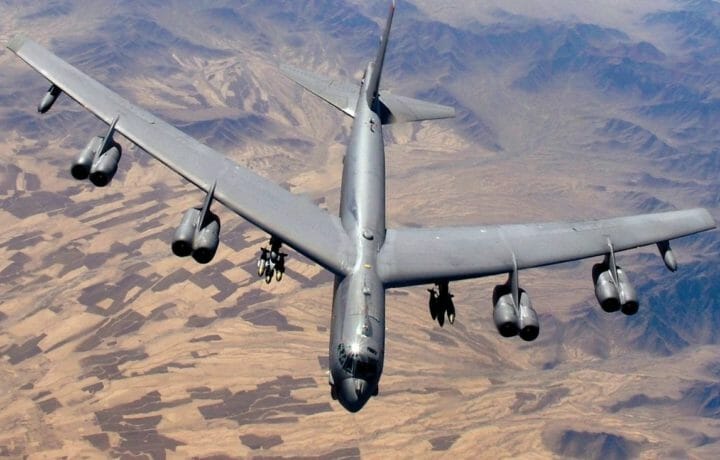This week, a still under-development hypersonic missile system failed to launch from the wing of a specially modified and upgraded Boeing B-52 Stratofortress. It was the eighth and most recent test to determine how the Cold War era bomber could be armed with the advanced AGM-182A Air-launched Rapid Response Weapon (ARRW), and it was the first to end in a failure. The 419th Flight Test Squadron and the Global Power Bomber Combined Test Force were involved in the testing.
The B-52H took off from Edwards Air Force Base (AFB), CA and was flying over the Point Mugu Sea Range during the scheduled flight to conduct the first booster test vehicle for the ARRW. However, the booster failed to complete its launch sequence, and the test missile was retained on the bomber. It will be examined to determine the fault.
A Setback for the Air Force
The United States Air Force called the failure a setback. It was the first launch test, which followed seven captive carriage missions. Engineers and testers will next explore the reason for the failure, and that will include checking for any defects in the system, while the vehicle will still be employed in future demonstrations.
Objectives for the test were to include demonstrating the safe release of the booster test vehicle for the B-52H. In addition, the test was meant to assess booster performance, booster-shroud separation, and simulated glide separation.
“The ARRW program has been pushing boundaries since its inception and taking calculated risks to move this important capability forward,” said Brig. Gen. Heath Collins, armament directorate program executive officer via a statement. “While not launching was disappointing, the recent test provided invaluable information to learn from and continue ahead. This is why we test.”
The Hypersonic Weapon Race
The ARRW program aims to deliver a conventional hypersonic weapons capability to the United States military by the middle of the decade. However, the United States is not alone in trying to develop the technology.
Both Russia and China are also working on respective systems, and the Russian Navy’s Northern Fleet has conducted multiple tests of the Tsirkon hypersonic missile including launches from the Project 22350 frigate Admiral of the Soviet Union Fleet Gorshkov from the White Sea to a target range 450 km away in the Barents Sea.
Russia has also been exploring ways to mount its hypersonic weapons on aircraft.
In his February 2019 State-of-the-Nation Address to the Federal Assembly, Russian President Vladimir Putin announced that the work on the Tsirkon hypersonic missile was proceeding as scheduled. The Russian leader added the missile platform was capable of reaching speeds of about Mach 9 and that its strike range exceeded 1,000 km (600 miles). At such speeds, it could reach a target at that distance in just seven minutes.
The combination of speed, maneuverability, and altitude could make tracking and intercepting such hypersonic weapons quite difficult to counter. However, development of these weapons has been slow going, and Russian has been working on its Tsirkon – also known as the 3M22 Zircon – for more than 20 years.
U.S. Hypersonic MIssile Efforts
The AGM-183A ARRW (pronounced “Arrow”) is reportedly capable of reaching speeds between 5,000 and 6,000 miles per hour, or roughly between Mach 6.5 and Mach 8. While slower than the Russian missile (or at least Moscow’s claims), at such speed the ARRW missile could still strike a target 1,000 miles away in just ten to twelve minutes. The ARRW is made up of a solid-fuel rocket booster that is topped by an unpowered boost-glide vehicle; and the rocket booster can propel the missile to hypersonic speeds after which the glide vehicle detaches and continues to the target.
Along with its greater speeds, hypersonic missiles also have the ability to maneuver with computerized precision, something that could make it all the more difficult to counter. Moreover, a hypersonic missile’s speed and force are so significant that it can inflict damage by its sheer ‘kinetic’ impact without even needing explosives.
Developing the weapons that can travel at such speed has required a serious investment of time and money however. The United States military isn’t working on a single option either.
According to a Government Accountability Office (GAO) report released in late March, the United States has spent about $14 billion towards the development of hypersonic weapons and related technologies since 2015, through 70 identified efforts. The GAO also noted that dozens of Department of Defense (DoD) agencies are working on hypersonic development. Due to a lack of guidance, GAO has recommended that the efforts are better coordinated, with better defined roles for those leading the projects.
One contractor that is in full support of the growth of hypersonic technology is Lockheed Martin. Lockheed is developing several hypersonic missiles for the U.S. military, and as the end of last year, the company had “north of $3 billion” in hypersonic-related offers.
If only the efforts to develop the technology could be employed at hypersonic speeds as well.




